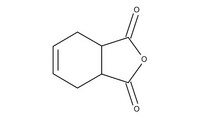800742 Sigma-Aldrich1,2,3,6-Tetrahydrophthalic anhydride
1,2,3,6-Tetrahydrophthalic anhydride for synthesis. CAS 85-43-8, pH 2.1 (10 g/l, H₂O, 20 °C).
More>> 1,2,3,6-Tetrahydrophthalic anhydride for synthesis. CAS 85-43-8, pH 2.1 (10 g/l, H₂O, 20 °C). Less<<Synonyms: 4-Cyclohexene-1,2-dicarboxylic anhydride
Recommended Products
Overview
| Replacement Information |
|---|
Key Spec Table
| CAS # | EC Number | Hill Formula | Molar Mass |
|---|---|---|---|
| 85-43-8 | 201-605-4 | C₈H₈O₃ | 152.14 g/mol |
Products
| Catalogue Number | Packaging | Qty/Pack | |
|---|---|---|---|
| 8.00742.0100 | Plastic bottle | 100 g | |
| 8.00742.1000 | Plastic bottle | 1 kg |
| Description | |
|---|---|
| Catalogue Number | 800742 |
| Synonyms | 4-Cyclohexene-1,2-dicarboxylic anhydride |
| References |
|---|
| Product Information | |
|---|---|
| CAS number | 85-43-8 |
| EC index number | 607-099-00-5 |
| EC number | 201-605-4 |
| Hill Formula | C₈H₈O₃ |
| Molar Mass | 152.14 g/mol |
| HS Code | 2917 20 00 |
| Structure formula Image | |
| Quality Level | MQ200 |
| Applications | |
|---|---|
| Application | 1,2,3,6-Tetrahydrophthalic anhydride for synthesis. CAS 85-43-8, pH 2.1 (10 g/l, H₂O, 20 °C). |
| Biological Information |
|---|
| Dimensions |
|---|
| Materials Information |
|---|
| Toxicological Information | |
|---|---|
| LD 50 oral | LD50 Rat 5410 mg/kg |
| Safety Information | |
|---|---|
| Categories of danger | irritant, sensitizing, dangerous for the environment |
| Product Usage Statements |
|---|
| Storage and Shipping Information | |
|---|---|
| Storage | Store below +30°C. |
| Packaging Information |
|---|
| Supplemental Information |
|---|
| Specifications | |
|---|---|
| Assay (morpholine method) | ≥ 97.0 % |
| Melting range (lower value) | ≥ 99 °C |
| Melting range (upper value) | ≤ 102 °C |
| Identity (IR) | passes test |
| Global Trade Item Number | |
|---|---|
| Catalogue Number | GTIN |
| 8.00742.0100 | 04022536362137 |
| 8.00742.1000 | 04022536362144 |









